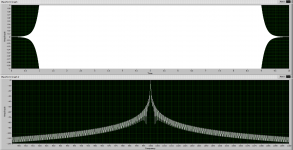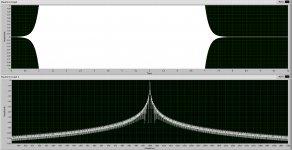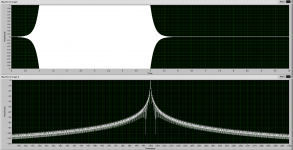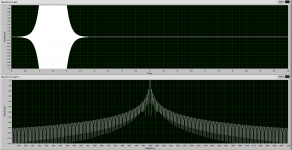Ok, thanks for reinforcing what I already know, I am interested in rough amplitudes of such sidebands.
The answer is... it depends on all the details you left out.
I made a few plots... if you want exact numbers, give me details and I'll send the numbers.
My laziness and assumptions: 1kHz. 10 sec record. Linear rise and fall from/to -60dB - 0dB in 1s. 8, 6, 4 and 1 second at 0dB, plus the rise and fall; the rest is at -60dB. Values normalized to 1 in time domain, 0dB in frequency domain.
Questions? Just ask...
Attachments
Scott’s wurcer multitone test file is here (for 64k FFT)A proposal-
First a multitone signal is a decent test and can show response, and nonlinear distortion but the challenge is keeping both harmonics and IM products from landing on tones. There was a paper published years ago at the AES with proposed collections of tones. I believe I shared a spreadsheet of those some time ago here
https://linearaudio.net/sites/linearaudio.net/files/30multitone_flat_96.wav
https://linearaudio.net/sites/linearaudio.net/files/30multitone_flat_48.wav
I had made an analysis, on which harmonics fall in the tone bins Digitizing vinyl
Demian’s (1audio) spreadsheet with proposed frequencies for multitone test files is here
John Curl's Blowtorch preamplifier part II
George
When we say that the frequency of something is 1kHz we have to say over what time period for this to have any meaning. Unless, of course, we are in the pure frequency domain in which case the 1kHz lasts for ever but it is probably only one component of the total signal. There is a form of uncertainty principle in operation: the closer we specify the frequency (i.e. narrower bandwidth of either the signal or our apparatus) the less we know about the duration of the signal or when it happened. Most of the time we work quite happily with a mix of frequency and time and don't even think about it. This can lead to problems, like the debates last century about whether the sidebands of AM were real or 'mathematical'; they are, of course, both in the sense that the maths says they are present and careful measurement confirms this. If you worked only in the time domain you would see the carrier amplitude varying and would know nothing about sidebands; if you worked only in the frequency domain you would see the sidebands and know nothing about the modulation - yet both views contain a complete description of what is happening. Both are real (not models).
Just to confuse some people you can tell them that in AM the carrier does not vary in amplitude (but sidebands appear) whereas in FM the carrier amplitude (but not its frequency) depends on the modulation.

FFT stands for Fast Fourier Transform - so are you saying that the mathematical function that perfectly describes reality can't be plotted except by approximation & then only either in the frequency domain or the temporal domain but not both at the same time?Nobody said that FFT is reality; maybe that is your confusion: whenever we say "Fourier" you think 'FFT'? FFT is a popular method for calculating an approximate Fourier transform.
I'm saying that reality knows of no such transform - it is both amplitude & time, concurrently & we perceive both concurrently - we don't do no stinkin' transforms. 😉
So are you saying that there is a better way than sampling which would then not be an approximation?It is approximate because it is essentially a sampled method in the frequency domain.
Yes agreedIf you are purely in the frequency domain then temporal spread has no meaning. Just like in the pure time domain frequency spread has no meaning. That is why various wavelet options have been invented, so time and frequency can be considered together.
Yes, reality underlies all of these attempts to represent it using different models - again, that doesn't mean the models are reality!However, as I keep saying, all these different domains are merely different ways of viewing the same reality. None of them are models, although they can be used to construct models.
Last edited:
I'm saying that reality knows of no such transform - it is both amplitude & time, concurrently & we perceive both concurrently - we don't do no stinkin' transforms. 😉
Sorry it's known as the Heisenberg uncertainty principle, I'm afraid that if our physical hearing system is based on real not spirit science it has the same limitations.
Sorry it's known as the Heisenberg uncertainty principle, I'm afraid that if our physical hearing system is based on real not spirit science it has the same limitations.

No signal can be plotted except by approximation, whether in time or frequency domain. However, that does not mean that the signal does not really exist. FFT is an algorithm: a set of instructions for quickly calculating an approximate Fourier transform (or its inverse). It requires sampling the time domain signal and the output in the frequency domain is also sampled (although the frequency samples are usually called bins).mmerrill99 said:FFT stands for Fast Fourier Transform - so are you saying that the mathematical function that perfectly describes reality can't be plotted except by approximation & then only either in the frequency domain or the temporal domain but not both at the same time?
There are also methods for doing time and frequency together, known as wavelets. You could think of a wavelet as being a precisely defined toneburst.
Forget FFT. Reality knows all about Fourier. One could argue that part of our hearing apparatus operates in the frequency domain.I'm saying that reality knows of no such transform
Yes. If you can describe the time domain signal as an analytic function then in some cases it is possible to determine the Fourier transform as an exact analytic function (or something like it). See any good engineering/physics/maths textbook; some may even have a table of Fourier transforms in an appendix at the back.So are you saying that there is a better way than sampling which would then not be an approximation?
You are confirming that you still don't get it. If you have no background in physical science or mathematics then that is not too surprising.Yes, reality underlies all of these attempts to represent it using different models - again, that doesn't mean the models are reality!
Forget FFT. Reality knows all about Fourier. One could argue that part of our hearing apparatus operates in the frequency domain.
You are confirming that you still don't get it. If you have no background in physical science or mathematics then that is not too surprising.



While I would not agree to mmerrill99 (assumed that I understand his point of view correctly) as our current model of our auditory processing/function includes that such transforms take place, it includes otherwise that, like he states, that it constantly uses both frequency and time informations.
Ad hoc, I don't understand why scott wurcer's generally correct reference to the uncertainty principle (wasn't it the Fourier uncertainty in this case? ) contradicts this, as it basically just says a resolution limit exists.
Further it seems, that DF96 argues with an idealized version of transform results which are in reality quite rare.
Approximations are common and ,based on simplifications, for example the spectral graphs usually don't show all the informations needed for a complete picture (of the approximation).
What am I missing?
Nah, you mean as long as nobody asks for specific, don't you?
I'd be interested what the "straw man" in my post was, but ....wait...."I don't hold my breath".
Otherwise, it seems ago to me that is a nice example for "projection" ; for example <nitpicking> comes to mind, never seen in one of your (even recent) posts, mhm? 🙂
Overall, the spin doctor believing his own spin is most likely the most convincing version, but isn't it kind of tragic too?
Ad hoc, I don't understand why scott wurcer's generally correct reference to the uncertainty principle (wasn't it the Fourier uncertainty in this case? ) contradicts this, as it basically just says a resolution limit exists.
Further it seems, that DF96 argues with an idealized version of transform results which are in reality quite rare.
Approximations are common and ,based on simplifications, for example the spectral graphs usually don't show all the informations needed for a complete picture (of the approximation).
What am I missing?
A nice collection to be saved for future reference.
Nah, you mean as long as nobody asks for specific, don't you?
I'd be interested what the "straw man" in my post was, but ....wait...."I don't hold my breath".
Otherwise, it seems ago to me that is a nice example for "projection" ; for example <nitpicking> comes to mind, never seen in one of your (even recent) posts, mhm? 🙂
Overall, the spin doctor believing his own spin is most likely the most convincing version, but isn't it kind of tragic too?
What am I missing?
If you do not understand the theory, then more or less everything.
@tapestryofsound,
Nah, I'm not an enemy.
But if you take a look at the typical graph in chris719 post:
John Curl's Blowtorch preamplifier part III
you'll see what is missing.
@ mountainman bob,
It was an example measurement from Klippel's website:
Multi-tone distortion
there are some informations included, but more insights to find in other publications on their website.....
If you do not understand the theory, then more or less everything.
Nah, I'm not an enemy.
But if you take a look at the typical graph in chris719 post:
John Curl's Blowtorch preamplifier part III
you'll see what is missing.
@ mountainman bob,
What causes those distortions to spike so much between 2k and 5khz?
That is supposedly right in the most sensitive area for human hearing......would there be any benefit in working on decreasing that 2-5k spike?
It was an example measurement from Klippel's website:
Multi-tone distortion
there are some informations included, but more insights to find in other publications on their website.....
@tapestryofsound,
But if you take a look at the typical graph in chris719 post:
John Curl's Blowtorch preamplifier part III
you'll see what is missing.
I kindly ask, tell me what you see that is missing.
Ad hoc, I don't understand why scott wurcer's generally correct reference to the uncertainty principle (wasn't it the Fourier uncertainty in this case? ) contradicts this, as it basically just says a resolution limit exists.
Huh? (My turn 🙂), Yes a mutual resolution limit between simultaneous aspects of time/frequency, position/momentum they are all analogous. What is contradicted, for a signal the time and frequency domain can not be simultaneously known to arbitrary resolution?
Forget FFT. Reality knows all about Fourier. One could argue that part of our hearing apparatus operates in the frequency domain.
If the hearing mechanism involves silia ( hairs?) that respond to small freq. bands than its very similar to FFTs. The ear coverts a time dependant air pressure signal into its time dependant freq. components ( sine waves ). If this is the case than using a FFT models to correlate to our hearing would make sense.
Why do some people have a problem with modeling physical systems, like with FFTs. Its the basis for almost all engineering. Sure its not perfect but its what we have and it keeps getting more accurate. Look how far SPICE has come.
Is it because the models dont agree with there ideology ?
Sorry it's known as the Heisenberg uncertainty principle, I'm afraid that if our physical hearing system is based on real not spirit science it has the same limitations.
I know it's Heisenberg uncertainty principle but when measuring we often want to know what is the exact freq at an exact time. I know wavelets were developed to be able to have a better view into both freq & time
In auditory perception because it is recognizing & processing patterns, - it is dealing with sound streams - that is categorizing the mulitude of frequencies hitting the eardrum at every moment in time & analyzing/categorizing these various frequencies/timings into soundstreams - answering the constantly posed internal question "does this sound belong to the sax or the souzaphone" etc. It is doing a frequency/time analysis & relating recognizing/categorizing all the sound into sound objects & the soundstream over time coming from this objects.
This is not an averaging, it is real time
So fundamentally we are using an FFT which is an approximate & averaging tool & using a steady state signal & can only represent freq or time but not both together & extrapolating those measurements to a system (auditory perception) that uses real time analysis of amplitude & time across a long timeframe which allows pattern matching/mismatching & can sense when such mismatches occur.
So I may not know the exact time + amplitude of the mismatch but can often sense a mismatch has occurred. It may be a subtle as an unease with the sound & unwillingness to expose myself to it for too long or at the other end of that range, when no such mismatches occur it may result in a sense that the sound is much more natural & interesting than the usual playback sound.
Enough of the Fourier denier stuff, (not you particularly, Scott W) - I'm trying to have a reasonable discussion
I might be dumb but no dumber than those who don't understand auditory perception - we are all trying to learn (or at least, I am)
Last edited:
While I would not agree to mmerrill99 (assumed that I understand his point of view correctly) as our current model of our auditory processing/function includes that such transforms take place, it includes otherwise that, like he states, that it constantly uses both frequency and time informations.
Why don't you ask him directly? Seriously, and also why don't you ask him about sine waves not modeling music, he my give you a straight answer. I'm glad you also have trouble understanding his point of view.
If the hearing mechanism involves silia ( hairs?) that respond to small freq. bands than its very similar to FFTs. The ear coverts a time dependant air pressure signal into its time dependant freq. components ( sine waves ). If this is the case than using a FFT models to correlate to our hearing would make sense.
The ear is basically a resonant system, therefore it responds to sine waves 🙂
Why don't you ask (Merrill) directly? Seriously, and also why don't you ask him about sine waves not modeling music, he may give you a straight answer. I'm glad you also have trouble understanding his point of view.
Effing hard being a creative genius, feeling better today.

I understand the structure of language without having to understand the substance of what is being described. I do not understand either Merrill or Jacob2 in their use of language. Therefore I can see that they do not know or understand what they are talking about.
The ear is basically a resonant system, therefore it responds to sine waves 🙂
Exactly, so the ear has to break down the signal into its frequenciy components, like an FFT, and if music dosnt consist of sine waves, how do we hear it?
Exactly, so the ear has to break down the signal into its frequenciy components, like an FFT, and if music dosnt consist of sine waves, how do we hear it?
Our relationship with sound is genetically programmed into us. Our ears, no more than a complex form of skin, is part of the organic bodily spacesuit that connects us to the world. Break down sound to its simplest component form of the sine wave, and that is what the body responds to by turning the pressure of impacting sound into electric pulses the mind interprets through its inbuilt neural processor as sound or music. There are big sounds like earthquakes, and there are tiny sounds like snails eating lettuce - all made of sine waves. One can only hear sound as represented by sine waves in the medium they travel in, such as air or water or rock.
Why does such a simple thing be of such baseless contention?
- Status
- Not open for further replies.
- Home
- Member Areas
- The Lounge
- John Curl's Blowtorch preamplifier part III



